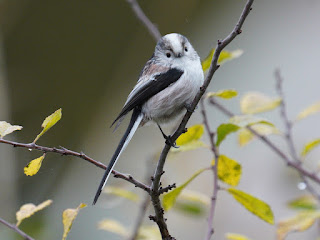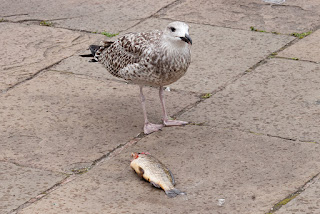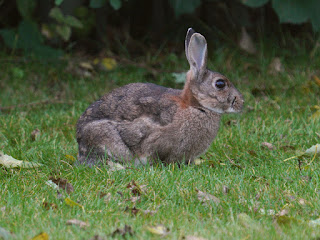There used to be a very tame Robin in the corkscrew hazel bush in the Flower Walk, but it disappeared. I think this is a new one. It was quite shy.
The usual Coal Tit came out to be fed.
A Long-Tailed Tit stared gravely at the camera.
A Blackbird ate rowan fruit in the trees on Buck Hill.
A male Chaffinch harmonised with the pink bark of an arbutus tree in the Rose Garden.
The male Peregrine was in his usual place on the tower. I haven't seen the female for a while, but pairs of Peregrines often stay apart for days at a time.
One of the youngest Great Crested Grebe chicks cruised by Peter Pan. It's remarkable how well camouflaged they are, with their stripy heads blending into the ripples.
Lesser Black-Backed Gulls and Black-Headed Gulls preened on posts on the Long Water. Preening is infectious, even between species: when one starts the others do it too.
The new influx of Lesser Black-Backs on the Long Water is not getting fed much by humans, and the birds have probably arrived to fish. Neil photographed a young one in the Italian Garden eating a carp which it presumably caught in one of the fountain pools.
There are now quite a few Gadwalls and Shovellers on the Long Water, more of both than last year. The Shovellers are winter migrants, but I think these Gadwalls just wander around from park to park.
Greylag Geese flew over the Serpentine.
A male Egyptian Goose (right) tried to encourage a female to mate. She was happy to join in the head-bobbing display, but then decided she wasn't in the mood and cruised off.
There was a rabbit under the Henry Moore sculpture. I think there's only one in the park now, since it looks like the one I've photographed earlier in the year with a patch of reddish fur on the back of its neck. It's looking tatty but at least it doesn't have myxomatosis, which killed a lot of rabbits a few years ago.
I hadn't noticed before that the iron plaque over the outflow of the Serpentine carries the letters SGHG. It is a parish boundary marker for the church of St George's Hanover Square a mile to the east. Before the modern social services system was set up it was the duty of parishes to care for the indigent. If a starving beggar was found east of the sign St George's would have to look after him, but if his corpse was found floating in the Serpentine it would be up to Paddington Parish to bury him.
The broken land drain in Kensington Gardens leaks water continuously, even in dry weather. Since the flow got heavier in the last couple of months it has created the beginnings of a real marsh on the lawn leading down to the Long Water. Repairs would be expensive and probably nothing will be done for years. The area is too wet to mow and will have to be left as it is. It will be interesting to see how marshland plants develop.
Tom was in the ancient marshland of Rainham, which has been much the same for thousands of years. He took this unusual picture of a Snipe chasing off two Cattle Egrets.













[Ralph, could you please delete the above comment? I used my husband's account to comment by mistake]
ReplyDeleteThat's a very brave Snipe! To think that we call it "agachadiza", "cowering".
Looking very forward to waching the new marsh develop. It would be very interesting to have it documented.
I am astounded that such a young gull managed to catch such a large carp!
Now I know why young grebes have stripey heads!
I think we may really get a bit of proper marsh. There's an area in Hyde Park which gets very marshy in wet weather, but it dries out after a fortnight without rain and has never had a chance to develop properly. This continuous leak could do the trick. I doubt we'll get any Snipe, though they are on the all-time list for the park. My great-grandfather said that when he was a boy he met an old man who had shot Snipe on the site of Paddington Station, which dates from 1838 though greatly expanded in 1854.
DeleteAnd apparently we get the word "sniper" from the shooting of Snipe. Very interesting information about the parish boundary marker. Is there a Paddington one in the area too? Jim
Delete